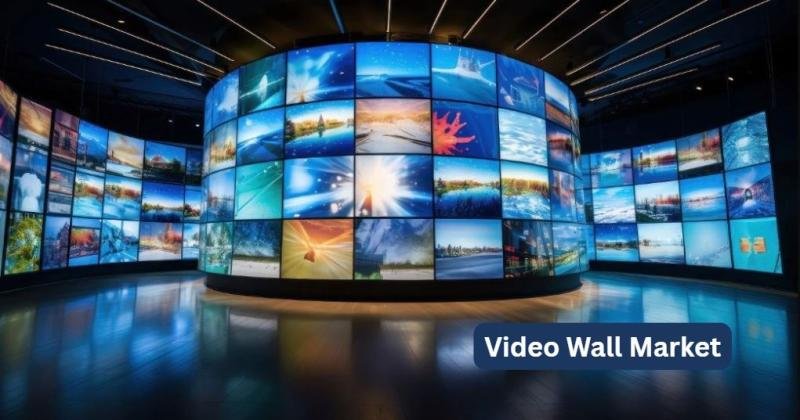Market Outlook
The Video Wall Market has experienced significant growth over recent years, driven by increasing demand across multiple industries. Valued at USD 8,020.00 million in 2018, the market reached USD 11,399.57 million in 2024 and is projected to achieve USD 27,241.89 million by 2032, reflecting a strong CAGR of 11.55% during the forecast period. This robust expansion underscores the rising importance of high-quality visual displays for communication, marketing, and operational purposes.
Video walls have become essential tools in sectors such as retail, government, entertainment, and education. Their ability to deliver dynamic, large-scale visual content makes them a preferred choice for both indoor and outdoor applications. With advancements in LED and LCD technologies, video walls now offer improved brightness, resolution, and energy efficiency, enabling businesses to enhance user engagement and deliver impactful visual experiences.
The global shift toward digital transformation further elevates the relevance of video walls. As organizations prioritize interactive and immersive communication channels, video walls play a critical role in bridging the gap between information delivery and audience engagement. The integration of AI-powered content management systems, remote monitoring capabilities, and modular designs is making video wall solutions more adaptable and cost-effective.
In the current global context, where visual communication is pivotal for branding, information dissemination, and customer engagement, the video wall market stands as a key enabler of digital strategies. With ongoing technological innovations and expanding use cases, the market is poised for continued growth across all major regions.
Preview the report with a detailed sample and understand how it can benefit your business strategy. Request a free sample today https://www.credenceresearch.com/report/video-wall-market
Market Drivers
Technological Advancements in Display Solutions
Continuous improvements in LED and LCD technology have significantly enhanced video wall performance. Higher pixel density, better brightness control, and energy-efficient designs have made video walls suitable for diverse applications, from retail showrooms to control rooms. The development of microLED and OLED displays has also pushed the boundaries of resolution and color accuracy, enabling even more immersive visual experiences. Manufacturers are introducing modular designs that make installation more flexible and scalable for different settings. Furthermore, integration with content management systems allows for seamless updates and synchronization across multiple displays. These advancements have positioned video walls as a core solution in industries that demand precision, clarity, and impact in their visual communications.
Rising Demand for Digital Signage in Retail
Retailers are increasingly adopting video walls to create immersive shopping experiences. By delivering visually appealing product displays, brands can attract customer attention, drive foot traffic, and increase conversion rates. Dynamic, high-definition visuals are replacing static signage, giving businesses the ability to adapt campaigns in real time. Retail environments are leveraging interactive video walls to allow customers to engage directly with products or promotions. This personalization enhances brand loyalty and increases customer dwell time. Additionally, the rise of omnichannel retailing has made video walls a vital link between online branding and in-store experiences, ensuring cohesive marketing strategies across platforms.
Expansion of Smart Cities and Public Infrastructure
Governments worldwide are integrating video walls into transportation hubs, public squares, and command centers. These installations are essential for real-time communication, surveillance, and information sharing. Video walls provide authorities with enhanced situational awareness, enabling faster and more coordinated responses during emergencies. Public-facing video walls in city centers also serve as tools for cultural promotion, event announcements, and community engagement. As investments in smart city infrastructure grow, demand for reliable, high-performance video wall systems is expected to rise significantly. Partnerships between governments and technology providers are further accelerating adoption by offering turnkey solutions that meet both security and communication needs.
Growing Popularity in Entertainment and Sports
Stadiums, concert venues, and theme parks are embracing large-scale video walls for live broadcasts, event information, and interactive content, enhancing audience engagement and overall experiences. High-brightness and weather-resistant models allow for outdoor installations that maintain visual quality in varying conditions. Video walls are also used for augmented reality (AR) and virtual reality (VR) integrations, creating unique fan experiences that go beyond traditional viewing. In esports arenas and gaming events, video walls provide immersive backdrops and real-time scoreboards, adding to the competitive atmosphere. As live events continue to draw large audiences post-pandemic, the role of video walls in delivering impactful visual storytelling is becoming increasingly indispensable.
Market Challenges
High Initial Investment Costs
Video wall installations involve substantial upfront expenses for hardware, installation, and integration, which can limit adoption among small and medium enterprises. The cost often includes specialized infrastructure upgrades and custom software to operate the system effectively. While prices for LED and LCD panels have gradually declined, the investment remains significant for organizations without large capital budgets. Financing solutions and leasing models are emerging to address this barrier, but cost sensitivity remains a challenge for market penetration.
Complexity in Installation and Maintenance
Setting up large-scale video walls requires skilled professionals and specialized equipment, adding complexity to deployment and ongoing maintenance. Misalignment or calibration issues can affect display quality, requiring periodic adjustments. Moreover, the integration of multiple hardware and software components increases the likelihood of technical issues over time. Businesses often need dedicated technical teams or third-party service providers to ensure optimal performance, which adds to long-term operational costs.
Rapid Technological Obsolescence
Frequent innovations in display technology can render existing systems outdated quickly, forcing businesses to reinvest earlier than planned. This rapid evolution poses a challenge for companies aiming to maximize ROI on their initial installation. Organizations must carefully consider upgrade paths and scalability when selecting video wall solutions to avoid early redundancy. The pace of change also pressures manufacturers to keep up with consumer expectations while managing production costs.
Heat and Energy Consumption Issues
Large video walls consume significant power and may generate heat, requiring additional cooling systems, which can increase operational costs. This can be especially problematic in enclosed environments where air circulation is limited. Energy efficiency has become a key consideration for buyers, pushing manufacturers to develop panels with lower power requirements. Nevertheless, balancing brightness, performance, and energy savings continues to be a technical hurdle for the industry.
Market Opportunity
Integration with AI and Analytics
AI-powered video walls can analyze viewer engagement and adjust content in real time, creating personalized experiences. This capability allows advertisers to optimize campaigns dynamically, ensuring higher conversion rates. AI can also be used for predictive maintenance, identifying potential hardware failures before they occur. Such innovations improve operational efficiency and reduce downtime, further increasing the appeal of AI-integrated video wall systems.
Growth in Education and Training Applications
Educational institutions are using video walls for collaborative learning environments, making them a valuable tool for interactive teaching. Universities and training centers deploy these systems for displaying complex visual data, virtual simulations, and remote lectures. Video walls also support blended learning models, combining in-person and online education seamlessly. Their ability to facilitate large-scale visual collaboration positions them as a key asset in modern education strategies.
Expansion in Healthcare Facilities
Hospitals and clinics are deploying video walls for patient communication, data visualization, and medical training. Surgical theaters use them for live imaging, while waiting areas display health information and updates. In medical education, video walls allow for high-resolution demonstrations of procedures and anatomy, improving learning outcomes. The healthcare sector’s focus on technology adoption is creating a sustained demand for such advanced visual solutions.
Emerging Markets Adoption
Rapid urbanization in emerging economies presents a vast opportunity for deploying video walls in commercial and public spaces. Countries in Asia Pacific, Latin America, and Africa are investing in modern infrastructure that often incorporates advanced display technologies. Affordable manufacturing options and declining hardware costs are also making video walls more accessible to these regions. As these markets continue to expand their digital ecosystems, video walls are set to play a central role in public engagement and information sharing.
Market Segmentation
By Component:
• Hardware
• Software
• Services
By Display Technology:
• LED
• LCD
• Other Categories
By Industry:
• Government & Public
• Retail & Consumer Goods
• Travel & Hospitality
• Education
• Healthcare
• Media & Entertainment
• Others
By Region
• North America
o U.S.
o Canada
o Mexico
• Europe
o UK
o France
o Germany
o Italy
o Spain
o Russia
o Belgium
o Netherlands
o Austria
o Sweden
o Poland
o Denmark
o Switzerland
o Rest of Europe
• Asia Pacific
o China
o Japan
o South Korea
o India
o Thailand
o Indonesia
o Vietnam
o Malaysia
o Philippines
o Taiwan
o Rest of Asia Pacific
• Latin America
o Brazil
o Argentina
o Peru
o Chile
o Colombia
o Rest of Latin America
• Middle East & Africa
o GCC Countries
o South Africa
o Rest of the Middle East and Africa
Regional Analysis
North America
North America remains a leading market for video walls, driven by strong adoption in retail, corporate, and public sectors. The U.S. leads the region due to high technology penetration and demand for advanced digital signage. Investment in sports stadiums, entertainment venues, and control rooms continues to fuel growth. Canada and Mexico are also witnessing increased adoption in transportation hubs and public spaces. Strong competition among manufacturers in the region encourages continuous innovation and price competitiveness.
Europe
Europe demonstrates steady growth, supported by smart city projects and retail modernization. The UK, Germany, and France are major contributors to regional demand. Government-backed infrastructure projects often integrate video walls for surveillance and communication. Cultural institutions such as museums and galleries also deploy these systems for interactive exhibitions. Energy-efficient solutions are gaining traction in the region, aligning with Europe’s environmental sustainability goals.
Asia Pacific
Asia Pacific is projected to register the fastest growth, fueled by rapid urbanization, infrastructure development, and growing retail sectors in China, India, and Southeast Asia. Mega events, such as international sports tournaments and expos, drive large-scale installations. The region also benefits from competitive manufacturing hubs that reduce costs for local buyers. Increasing investments in education and transportation infrastructure further expand the market potential.
Latin America
Latin America’s market is expanding as businesses in Brazil, Mexico, and Chile embrace digital transformation to improve customer engagement and operational efficiency. Video walls are being adopted in shopping malls, airports, and government facilities. Regional growth is supported by a growing middle class and the rising popularity of large public events. Partnerships with global technology companies are introducing more advanced systems to the region.
Middle East & Africa
The Middle East & Africa market benefits from large-scale infrastructure investments, particularly in the UAE and Saudi Arabia, where entertainment, retail, and tourism projects drive demand. Video walls are being incorporated into luxury malls, stadiums, and cultural centers. In Africa, digitalization efforts in countries like South Africa are opening new avenues for deployment. The hospitality sector is also emerging as a significant adopter in this region.
Top Companies
• Sony Corporation
• Samsung Electronics Co Ltd
• Koninklijke Philips N.V
• Panasonic Corporation
• Adow Networks
• NEC Display Solutions
• Navori SA
• Omnivex Corporation
• AU Optronics Corp
• Toshiba Corporation
• Electronic Displays Inc
• ViewSonic Corporation
Recent Developments
• In June 2025, Sony Electronics introduced the Crystal LED CAPRI series, expanding its LED display portfolio. Designed for virtual production in television, film, and broadcasting, this product makes advanced video wall technology more accessible to creative industries.
• In September 2024, PPDS, in partnership with Oracle Red Bull Racing, unveiled a record-breaking 46.25-meter-wide Philips dvLED video wall at the MK 7 venue, recognized as Europe’s largest indoor dvLED wall. The installation was revealed during a PPDS event on September 10.
Reasons to Purchase this Report:
• Gain in-depth insights into the market through both qualitative and quantitative analyses, incorporating economic and non-economic factors, with detailed segmentation and sub-segmentation by market value (USD Billion).
• Identify the fastest-growing regions and leading segments through analysis of geographic consumption trends and the key drivers or restraints affecting each market.
• Track the competitive landscape with updated rankings, recent product launches, strategic partnerships, business expansions, and acquisitions over the past five years.
• Access comprehensive profiles of key players, featuring company overviews, strategic insights, product benchmarking, and SWOT analyses to assess market positioning and competitive advantages.
• Explore current and projected market trends, including growth opportunities, key drivers, challenges, and limitations across developed and emerging economies.
• Leverage Porter’s Five Forces analysis and Value Chain insights to evaluate competitive dynamics and market structure.
• Understand how the market is evolving and uncover future growth opportunities and emerging trends shaping the industry.
Related Reports –
Micro-LED and Advanced Display Driver ASIC Market- https://www.credenceresearch.com/report/micro-led-and-advanced-display-driver-asic-market
3D IC and 2.5D IC Packaging Market- https://www.credenceresearch.com/report/3d-ic-and-2-5d-ic-packaging-market
Follow Us:
https://www.linkedin.com/company/credenceresearch/
https://www.facebook.com/CredenceResearch
Credence Research Europe LTD – 128 City Road, London, EC1V 2NX, UNITED KINGDOM
Credence Research is a viable intelligence and market research platform that provides quantitative B2B research to more than 2000 clients worldwide and is built on the Give principle. The company is a market research and consulting firm serving governments, non-legislative associations, non-profit organizations, and various organizations worldwide. We help our clients improve their execution in a lasting way and understand their most imperative objectives.
This release was published on openPR.















